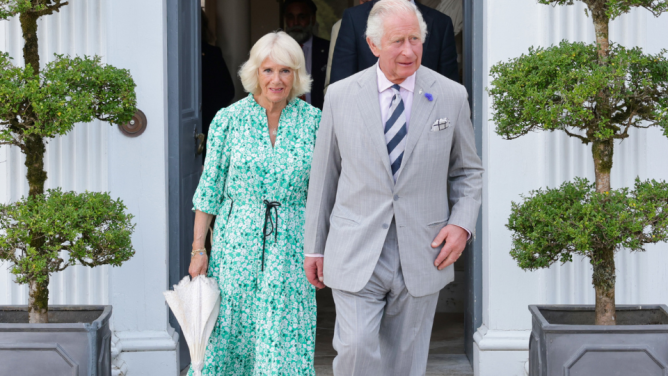Prince Charles ascended to the throne as King Charles III after the death of his mother, Queen Elizabeth II, on September 8, 2022. The 96-year-old died “peacefully” surrounded by immediate family in Balmoral Castle in Scotland. Charles released a statement shortly after news broke that his mother had passed, saying “The death of my beloved Mother, Her Majesty The Queen, is a moment of the greatest sadness for me and all members of my family. We mourn profoundly the passing of a cherished Sovereign and a much-loved Mother. I know her loss will be deeply felt throughout the country, the Realms and the Commonwealth, and by countless people around the world. During this period of mourning and change, my family and I will be comforted and sustained by our knowledge of the respect and deep affection in which The Queen was so widely held.” Charles’s wife, Camila Parker Bowles, former Duchess of Cornwall, has taken on a new title too as Queen Consort. But what does Queen Consort actually mean? We explain.
Camilla Parker Bowles King Charles. Getty Images
What does Queen Consort mean?
Queen Consort is the title given to the female partner to the King. It’s not a formal role but symbolizes this person’s support to the reigning monarch. For years, it was believed Camilla would become the princess consort, which would have been a first in British history but applied to Grace Kelly during her marriage to Rainier III, ruler of Monaco. At the time of Camila’s marriage to Charles in 2005, royal aides suggested that she did not want to be called Queen and had “intended” to be known as Princess Consort, leaving open the possibility of her changing her mind later. Titles were also a little sensitive at the time. Charles and the beloved Princess Diana had divorced (a royal scandal in its own right), partially due to his affair with Camilla. A year later, Diana died in a car crash aged 38. “Princess consort was a compromise that arose because of the sense of grief and anger, notably at the death of Princess Diana,” Royal family historian Dr. Cindy McCreery told ABC Australia. “But also at the resentment in many quarters towards Camilla for what many people felt was the improper relationship that Charles and Camilla had during the time that Charles was still married to Diana.”
Public perception of Camilla slowly shifted towards the positive, however. In late February 2022, Queen Elizabeth II supported the notion that her son’s wife would adopt the Queen Consort title. ‘’When, in the fullness of time, my son Charles becomes king, I know you will give him and his wife Camilla the same support that you have given me,’’ the Queen said in a statement the night before her Platinum Jubilee, which celebrated her 70th year as ruler of the British monarchy. “And it is my sincere wish that, when that time comes, Camilla will be known as Queen Consort as she continues her own loyal service.” Charles responded in his own statement shortly after, saying, “We are deeply conscious of the honor represented by my mother’s wish. As we have sought together to serve and support Her Majesty and the people of our communities, my darling wife has been my own steadfast support throughout.”

Prince Charles, Queen Elizabeth. Getty Images
How is it different from Queen?
Queen Consort is the title given to the spouse of the King, whereas the title of Queen, or Queen Regent, is designated for a woman who rules in her own right as Queen Elizabeth II did. The last Queen regent was Queen Victoria (1819-1901), whose husband Prince Albert was prince consort. Historically, the husbands of queens have taken that title rather than king consort. Dr McCreery said this is because the title of prince consort bolsters the authority of the woman. “When there’s been a queen ruling, it’s really important that her husband is not confused in people’s minds as somehow a king, and therefore he takes a title of prince consort.”
Does this mean we’ll have to call Camilla queen consort?
No. Just Queen Camilla will be fine. The title is used formally but not in general practice. “For example, with Queen Elizabeth II’s parents, her father was King George VI, her mother was queen consort,” Dr McCreery explained. “But in practice, she was known as Queen Elizabeth (her name was also Elizabeth). It might be the formal term, but we don’t in practice say the king and queen consort. We say king and queen.”

Image: Courtesy of Random House.
For more about the British royal family, check out Sally Bedell Smith’s 2012 biography, Elizabeth the Queen: The Life of a Modern Monarch
. The New York Times bestseller, which includes the “real story” behind several storylines featured in Netflix’s The Crown, follows Queen Elizabeth II’s life from her childhood as the “heiress presumptive” to her father, King George VI; to the moment he met her husband, Prince Philip, when she was 13 years old; to her ascension to the throne at 25 years old in 1952. Elizabeth the Queen, which also includes interviews with Buckingham Palace sources and never-before-revealed documents, provides a deep dive into the Queen’s legacy as one of the most famous monarchs in recent history.

